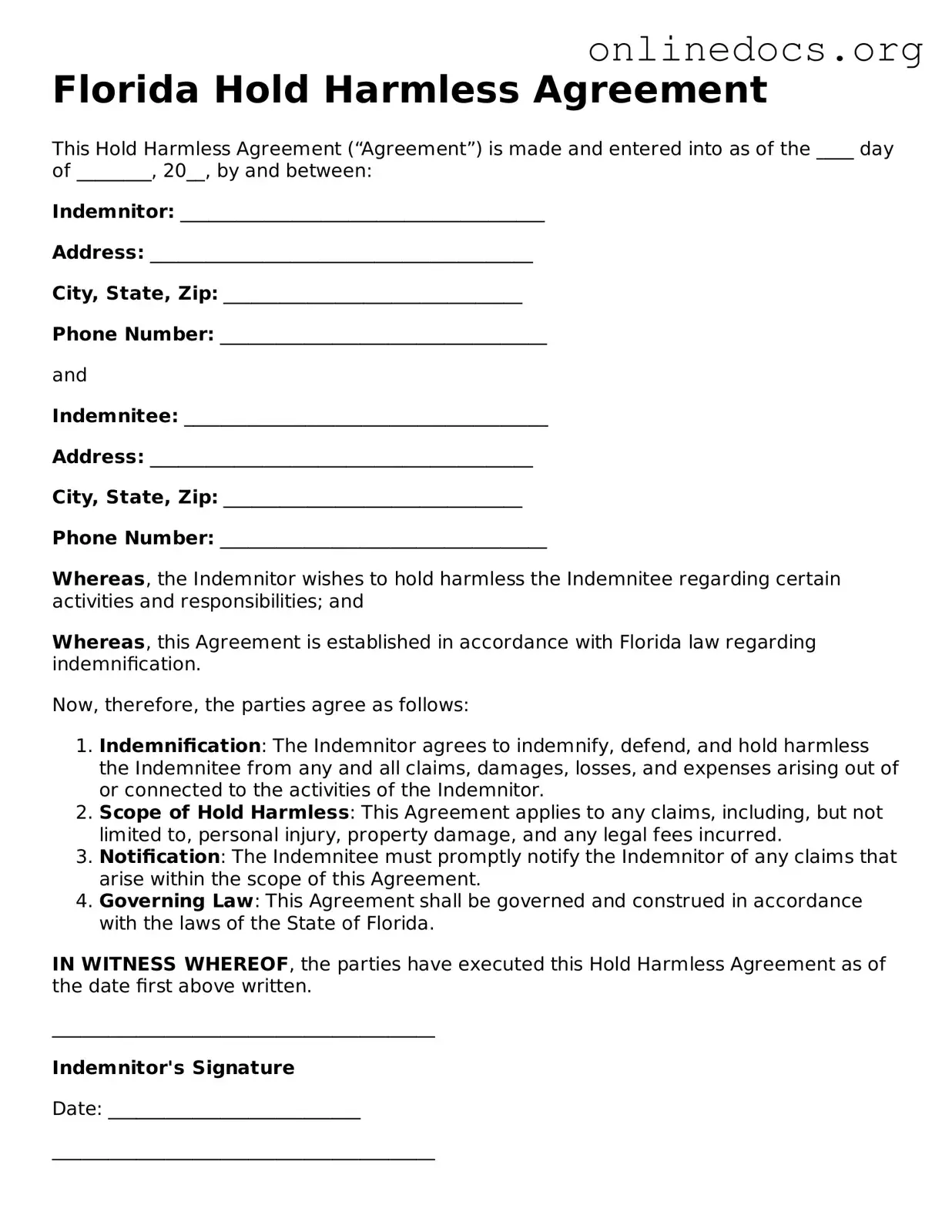The Indemnity Agreement serves a similar purpose as the Florida Hold Harmless Agreement. Both documents are designed to protect one party from financial loss or legal liability resulting from the actions or negligence of another party. An Indemnity Agreement often includes specific terms outlining the scope of indemnification, whereas the Hold Harmless Agreement may be broader in its language. Both agreements are commonly used in various contracts, particularly in construction and service industries, to allocate risk between parties.
The Waiver of Liability is another document that shares similarities with the Hold Harmless Agreement. This waiver is often used in recreational activities or events where participants agree not to hold the organizers liable for injuries or damages. Like the Hold Harmless Agreement, it seeks to protect one party from claims arising from accidents or negligence. However, the Waiver of Liability typically requires the participant's signature, indicating their acceptance of the risks involved.
The Release of Liability form also parallels the Hold Harmless Agreement. This document is often used when one party releases another from any future claims or liabilities. Both documents aim to limit legal exposure, but a Release of Liability may be more focused on relinquishing rights to sue after an incident occurs, while the Hold Harmless Agreement emphasizes ongoing protection against claims.
In the context of real estate transactions, the Property Management Agreement resembles the Hold Harmless Agreement. This document outlines the responsibilities of property managers and owners, often including clauses that protect the manager from liability related to tenant actions. Both documents serve to delineate responsibilities and protect parties from claims that may arise during the management of property.
The Service Agreement is another related document. It outlines the terms and conditions under which services are provided, often including provisions that limit liability for the service provider. Similar to the Hold Harmless Agreement, it aims to protect one party from claims resulting from the other party's actions or negligence during the service period.
Understanding the various forms related to liability can be intricate, yet crucial for effective risk management. For instance, a Tennessee Hold Harmless Agreement serves to safeguard one party from potential legal issues arising from particular activities or events. Moreover, individuals and organizations should also familiarize themselves with documents such as the Harmless and Indemnity Agreement, which helps clarify the responsibilities of the parties involved and mitigate risks effectively.
The Construction Contract is closely aligned with the Hold Harmless Agreement, particularly in its risk allocation provisions. This contract often includes clauses that require one party to indemnify the other for damages arising from construction activities. Both documents emphasize the importance of risk management and liability protection in construction projects.
The Lease Agreement can also be compared to the Hold Harmless Agreement, especially in commercial leases. Many lease agreements contain clauses that protect landlords from liability for injuries occurring on the premises. Both documents serve to clarify the responsibilities of the parties involved and provide a framework for handling potential claims.
The Non-Disclosure Agreement (NDA) shares some common ground with the Hold Harmless Agreement in terms of protecting one party's interests. While NDAs primarily focus on confidentiality, they can include indemnification clauses to protect against breaches. Both documents aim to safeguard parties from the repercussions of unauthorized disclosures or actions.
The Joint Venture Agreement is another document that can be likened to the Hold Harmless Agreement. In joint ventures, parties often agree to share resources and risks. This agreement may include indemnification clauses that protect each party from losses resulting from the other party's actions. Both documents emphasize the importance of risk sharing and liability protection in collaborative efforts.
Finally, the Partnership Agreement can be compared to the Hold Harmless Agreement, particularly in terms of liability protection among partners. This agreement outlines the roles and responsibilities of each partner and often includes provisions to indemnify partners for actions taken on behalf of the partnership. Both documents aim to establish clear expectations and protect parties from potential legal claims.
